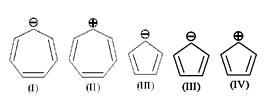Which of the following complex species is not expected to exhibit optical isomerism ?
[Co(en)2Cl2]+
[Co(NH3)3Cl3]
[Co(en)(NH3)2Cl2]+
[Co(en)3]3+
The correct Answer is:B
To determine which complex species is not expected to exhibit optical isomerism, we need to analyze the given coordination compounds and their structures. Optical isomerism occurs when a compound lacks any element of symmetry, allowing for non-superimposable mirror images (enantiomers).
1. Identify the Complex Species: The question presents four coordination compounds, all involving cobalt as the central metal ion. We will analyze each one for symmetry.
2. Analyze the First Complex:
- Complex: (Co(en)₂Cl₂)⁺
- Structure: The central cobalt is coordinated by two ethylene diamine (en) ligands and two chloride (Cl) ligands.
- Symmetry: This complex can exist in both cis and trans forms. In both forms, there is no plane of symmetry, which means it can exhibit optical isomerism.
Conclusion: This complex can exhibit optical isomerism.
3. Analyze the Second Complex:
- Complex: (Co(NH₃)Cl₃)
- Structure: Cobalt is coordinated by three ammonia (NH₃) ligands and three chloride (Cl) ligands.
- Symmetry: This complex can exist in facial and meridional isomers. Both forms have a plane of symmetry due to the arrangement of identical ligands, making them optically inactive.
Conclusion: This complex does not exhibit optical isomerism.
4. Analyze the Third Complex:
- Complex: (Co(en)(NH₃)₂Cl₂)⁺
- Structure: Cobalt is coordinated by one ethylene diamine, two ammonia ligands, and two chloride ligands.
- Symmetry: This complex can have different geometrical isomers, and all of them lack symmetry, allowing for optical isomerism.
Conclusion: This complex can exhibit optical isomerism.
5. Analyze the Fourth Complex:
- Complex: (Co(en)₃)³⁺
- Structure: Cobalt is coordinated by three ethylene diamine ligands.
- Symmetry: This complex has no plane of symmetry and can exist as enantiomers, thus exhibiting optical isomerism.
Conclusion: This complex can exhibit optical isomerism.
Final Answer:
The complex species that is not expected to exhibit optical isomerism is (Co(NH₃)Cl₃) (Option B).
- Complex: (Co(en)₂Cl₂)⁺
- Structure: The central cobalt is coordinated by two ethylene diamine (en) ligands and two chloride (Cl) ligands.
- Symmetry: This complex can exist in both cis and trans forms. In both forms, there is no plane of symmetry, which means it can exhibit optical isomerism.
- Complex: (Co(NH₃)Cl₃)
- Structure: Cobalt is coordinated by three ammonia (NH₃) ligands and three chloride (Cl) ligands.
- Symmetry: This complex can exist in facial and meridional isomers. Both forms have a plane of symmetry due to the arrangement of identical ligands, making them optically inactive.
- Complex: (Co(en)(NH₃)₂Cl₂)⁺
- Structure: Cobalt is coordinated by one ethylene diamine, two ammonia ligands, and two chloride ligands.
- Symmetry: This complex can have different geometrical isomers, and all of them lack symmetry, allowing for optical isomerism.
- Complex: (Co(en)₃)³⁺
- Structure: Cobalt is coordinated by three ethylene diamine ligands.
- Symmetry: This complex has no plane of symmetry and can exist as enantiomers, thus exhibiting optical isomerism.
The complex species that is not expected to exhibit optical isomerism is (Co(NH₃)Cl₃) (Option B).
Topper's Solved these Questions
Similar Questions
Knowledge Check
Which of the following species is not expected to be a ligand?
ANOBNH+4CNH2CH2CH2NH2DCO
Which of the following species is not expected to be a ligand?
View SolutionWhich of the following species is not expected to be a ligand?
View SolutionWhich of the following compounds is expected to exhibit optical isomerism?
[en ethylenediamine]
View SolutionAn octahedral complex having formula Ma2b2C2, which of the following combination is possible to exhibitd optical isomerism
View SolutionWhich one of the following is expected to exhibit optical isomerism (en=ethylenediamine)?
View SolutionWhich of the following species would be expected to exhibit aromatic character?

View SolutionWhich of the following complex is optically inactive
View Solution
